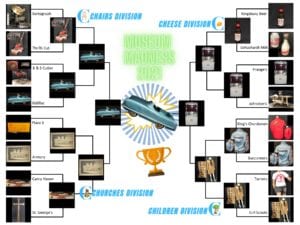
16 Ojbects — 4 C’s Divisions
Only one can be CHAMPION!
Presenting the 2021 Champion!
Kidillac, Garton Toy Company
circa 1950
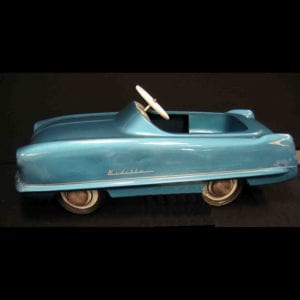
Kidillac, Garton Toy Company, circa 1950
Perhaps Garton’s most famous and best loved pedal car, the Kidillac, was designed to be a miniature replica of the real thing. The company employed one of the designers of the original Cadillac in creating the “streamline, 1950 design, built low for ease of propulsion… made of one-piece steel, no seams or joints to come apart,” which could be customized to match the family car. Like their other pedal cars, the Kidillac featured the quality details that Garton was known for — numbered license plates, detailed instrument panels, rubber wheels and more. This particular Kidillac was one enjoyed by the Garton family for generations.
Established in 1879 as the Garton Company, the firm initially produced common utilitarian products, including cigar boxes and washboards. By the early 1900s, Garton had transitioned into wheeled riding toys, establishing an impressive network of distribution centers and showrooms across the country. Sales offices in New York, Chicago, Dallas, and Los Angeles, alongside a program of national catalog sales, supported the growing business as the company expanded into sleds, wagons, croquet sets, water skis, and toy cradles. The expanding market, coupled with Garton’s attention to changing styles and designs as the century progressed, made the company a leading producer of pedal toys for over 75 years.

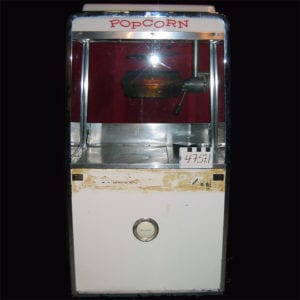
Cretors ‘Ambassador’ Popcorn Machine, H.C. Prange Company, 1966-1983
Going to the flagship Sheboygan store of regional department retail chain H.C. Prange Company was more than just a shopping trip. Customers could stop just for lunch at one of the company’s dining areas, pick up bakery, or get a quick and affordable snack of hotdogs and caramel corn. Likewise, one of Prange’s most beloved candy items was the Jumbo handmade Popcorn ball. This Cretors Ambassador model popcorn machine, considered to be top-of-the- line from the mid-1950s until the design was discontinued in the late 1960s, would easily have kept up with demand for not only a quick snack while shopping, but also the needs of the kitchen for a ready supply of popcorn to turn into a speciality treat. The machine was donated to the Museum by Sonlight Books, Prange’s neighbor, who had found it hardwired into their electrical.
Based at 8th and Wisconsin in Sheboygan, the H.C. Prange Company was a one-stop shop for the needs of Eastern Wisconsin residents. Founded in 1887 by Henry C. Prange, his sister Eliza, and Mr. J.H. Bitter, Prange’s began as a dry goods store. From day one, company leadership made sure that the newest merchandise was available to Sheboygan County residents and offered unique experiences, like the holiday window displays, life-size Steiff promotional animals, and popcorn for all. An outstanding selection coupled with an unbeatable customer service policy — “It’s Not Yours ‘Til You Like It!” – helped the Prange’s become the largest Wisconsin based department store chain with sales topping $250 million annually by 1984. The end of an era came in 1992, when Prange’s, including the Sheboygan flagship store, was sold to Younkers Inc.

Margaret Blocki Wunsch Uniform, Girl Scout Troop 2 Sheboygan, 1923 - 1928
Throughout the early 1920s, Margaret Blocki was a regular participant in the activities of the Girl Scouts, alongside her exceptional school scholarship, participation in numerous community plays and other local organizations. Many of the proficiency badges were earned between 1924 and 1927, when Miss Blocki was one of twenty-four scouts nationwide that were invited on a trip to Europe in recognition of Scouting accomplishments. The trip included several days at the International Girl Scout Camp in Geneva, Switzerland, where Blocki proudly wore her uniform. Following her graduation in 1928, Blocki was awarded a Golden Eaglet, the Girl Scouts highest honor at the time, and spent the summer as an instructor at the Kalamazoo Girl Scout Camp.
The Girl Guides of America was established in 1912 by Juliette Gordon Low. Low established the first troop in Savannah, Georgia and focused on developing an organization by and for women and girls that emphasized community service, self-reliance, and the outdoors. In 1913, the organization changed their name to Girl Scouts of the United States and within a decade had over 100,000 members across the United States. In 1919, two troops were established in Sheboygan, one at Grant School and the second at Mead Hall.

Architectural Rendering, Sheboygan Municipal Auditorium and Armory, 1940
As plans for a new Municipal Auditorium and Armory for Sheboygan were discussed, several building designs were proposed between 1935 and 1940. The final design, depicted in this hand drawn and colored rendering by local architect Edgar Stubenrauch, was approved in December 1940. The drawing remained at the Armory for years, after which it was also displayed in an office at City Hall. It was one of many items acquired by the Historical Society to help preserve the memories, activities, and more related to the Armory.
A Sheboygan native, Edgar A. Stubenrauch (1894-1988) opened his architectural firm in Sheboygan in 1921. Over the years, he designed numerous public buildings in the area, including the Sheboygan Post Office, the Taylor Hill Reservoir, South High School, and Sheboygan Memorial Hospital, along with countless personal residences. One of Sheboygan’s most prolific architects during his time, it was estimated that Stubenrauch and his firm were responsible for the design of over sixty-percent of area churches when he died in 1988 and had buildings of their design in over two-hundred communities.

Traffic Sign, Plaza 8 Pedestrian Mall, 1976-1990
Beginning in July 1976, visitors to the heart of Sheboygan found an impressive effort of urban revitalization featuring 600,000 red bricks underfoot, 250 trees above, and 5,350 flowers and bushes alongside. Plaza 8 was also home to the H.C. Prange Department Store, several specialty retailers, the newly built Mead Public Library, a decorative water feature, and several entertainment and dining venues. There were high hopes that the newly built pedestrian mall would provide not only a boost to the downtown economy and establishments, but an influx of new retailers and shoppers who enjoyed the benefits of leisure without the worry of vehicle traffic. This traffic sign reminded everyone that the stretch of 8th Street from Ontario Avenue to nearly Center Avenue was just for walking.
By the mid-1960s, City of Sheboygan leadership knew they were facing an increasingly empty downtown. A 1966 report completed by Midwest Planning and Research Company cited numerous challenges to the area, including aging and deteriorating buildings, inadequate traffic and parking infrastructure, and the reality of Wisconsin winters. The proposed solution was the creation of a tri-level enclosed shopping center spanning the heart of downtown. While the initial plan was never realized, the Sheboygan Redevelopment Authority’s plan for Plaza 8 was in many respects a modified version that emerged nearly ten years later. However, the plaza faced challenges from the very beginning, even just to establish a name. None of the members of the Redevelopment Authority loved the name — based on the Spanish word for place and the original street — but an agreement on a better alternative could not be reached. Despite efforts throughout the 1980s, the bricks of Plaza 8 were torn out almost exactly fifteen years to the day of the original ribbon cutting.

Mission Cross, St. George Catholic Church, 1884-2007
As the population of Sheboygan County grew in the mid-1800s, countless churches began to emerge. At first, many were meetings at private homes until a formal parish was established. For the most prominent denominations, those formal parishes would then support additional mission churches in the area. St. George’s Catholic Church, which began as a mission outpost, soon had the membership to become an independent parish. This mission cross indicates that, in time, the church was able to support its own missions. When it was rediscovered years later, the cross needed considerable restoration. Deacon Sy Regan undertook the task, using special lighting and outlining what could be reproduced.
St. George’s began as a mission of St. Mary Magdalene Catholic Church in Sheboygan. As one of the earliest Catholic congregations, the church became an independent parish by 1860 and in 1867, the 101 members erected a new building in Six Corners. The church soon had St. Rose of Lima as a mission of its own. The thriving parish also supported a school, along with a number of social societies. Eventually, St. George, St. Rose and St. Mary in Sheboygan Falls merged to become Blessed Trinity Parish. St. George was permanently closed in 2007.

Cutter Sleigh, Benedict & Schumann O.G. Carriage Works, circa 1880
A cutter-style sleigh, historically designed for two people and to be horse drawn, represents the quintessential winter vehicle of the 1800s. Benedict & Schumann O.G. Carriage Works manufactured this cutter around their 1880 relocation from their two-story building, newly built in 1873, to a smaller location on Broadway in Sheboygan Falls. Years later, Robert and Helen McCabe purchased the cutter at an auction for $5.50 for use by their family. Robert would hook the cutter up to the family’s John Deere tractor and travel the country roads of Sheboygan County with Helen and their two children tucked under a horsehair blanket in the sleigh.
Herman Schumann (1840-1930) emigrated to Wisconsin in 1855. After settling in Sheboygan Falls, Schumann learned the carriage-making trade, eventually entering into a partnership with Josiah Benedict (1823-1896). Both men had worked with another well-known carriage maker, William Servis, prior to opening their joint establishment. Together, the two manufactured and serviced a variety of carriages and sleighs, with Benedict providing blacksmith services, while Schumann worked on the bodies. Following Benedict’s death, Schumann continued on with limited success.
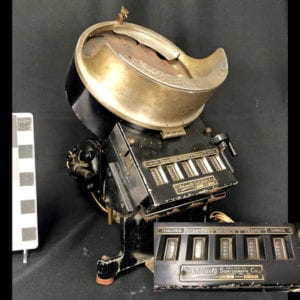
Coin Sorter, The Schwartz Sortograph Company, 1925
Legend has it that Carl Schwartz saw a motorman turn in the coin receipts of the day to the office at the Sheboygan Falls streetcar station and was inspired to develop a better way to count the day’s take. He set to work creating the Sortograph. Besides the ability to sort over a thousand coins in less than a minute, Schwartz fitted his invention with an optional attachment that could be used for public transit tokens. After extensive testing, the Sortograph was ready for the world, selling for $300. An additional component that would also provide totaling capabilities brought the total to $600. This example, originally purchased by the Bank of Elkhart Lake, is one of only two-hundred that the company self-produced before selling the patent for the machine to the Brandt Automatic Cashier Company in Watertown.
Hungarian born Carl Schwartz (1885-1955) was a mechanical genius, learning the ins-and-outs of machine shops, tool and die making, and business as he traveled the world after leaving Budapest at age 19. By the time he settled in Sheboygan Falls following World War I, Schwartz was well on his way to over one-hundred inventions and patents. After developing the Sortograph, he moved to Elkhart Lake, where later inventions included the first device to automatically calculate the total cost of gasoline pumped into a vehicle as it was dispensed, a commercial record changer for jukeboxes, and a device to precisely measure fabric yardage, aptly known as the Measurer-graph. One of his final inventions, made in consultation with the Passini Cheese Factory of Plymouth, was a machine to mechanise the stretching portion of Italian-cheesemaking, easing one of the most strenuous aspects of the process.
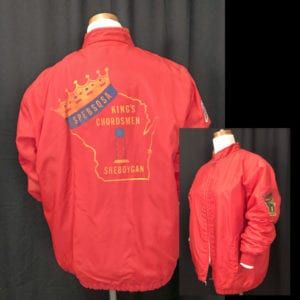
Member Jacket, King’s Chordsmen, 1965-1990
For over fifty years, barbershop singing was a mainstay of the Sheboygan area music scene.The tight four-part vocal music style had a strong following in the area, with several chapters of SPEBSQSA established. The comradery of groups, coupled with the joy of singing they brought, led to the very successful Sheboygan Chapter that performed regularly from 1945 through 1990. Numerous organized quartets became part of the local chapter, providing both entertainment and financial contributions for many local service clubs. This SPEBSQSA coat was worn by Edwin Karn, a local history professor who celebrated his love of music through participating in the local chapter, including several years as President of the organization.
The Society for the Preservation and Propagation of Barber Shop Singing in the United States grew out of a chance meeting in Missouri of two barbershop loving businessmen. Soon renamed to the Society for the Preservation and Encouragement of Barber Shop Quartet Singing in America, the organization quickly established chapters across the country. The Sheboygan Chapter of SPEBSQSA was established in 1945 with O.H. “King” Cole as President. The chapter came to be known as the King’s Chordsmen, open to any man dedicated to continuing the tradition of barbershop quartet style music.
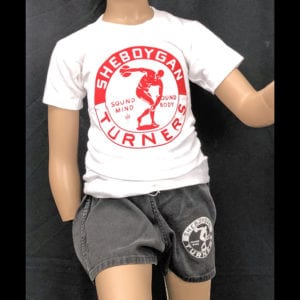
Youth Practice Uniform, Sheboygan Turners, 1970-1980
While often viewed as a gymnastic organization, Turner Societies promoted a variety of athletic endeavors, including track and field, volleyball, swimming, and tennis, alongside cultural and artistic activities. In addition to group drills and demonstrations, members of the organization participated in regular work-outs. While leotards remained an option, a t-shirt and shorts became the common practice uniform for young men & women in the second half of the 20th Century. It was not uncommon for boys and girls as young as 5 to join the organization’s classes. This particular practice set was worn by the members of the Udovich family, long time members and leaders in the Sheboygan Turners.
The Sheboygan Turnverein was chartered in 1854 as one of the first three Turner organizations to be established in Wisconsin. Originating in Germany in 1811, Turner philosophy promoted a “Sound Mind in a Sound Body” through vigorous exercise, alongside cultural and social activities. The Sheboygan Turners were one of the earliest established in Wisconsin, practicing initially in Fountain Park. Throughout the years members competed in Turner sponsored competitions and, during the 1940s and 1950s, numerous Sheboygan members went on to perform with national acrobatic companies. Sheboygan’s Turnverein remains one of the longest active in the state.
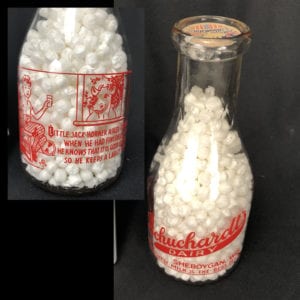
Nursery Rhyme Milk Quart, Schuchardt Dairy Sheboygan, 1940 - 1960
With the 1930s introduction of pyroglazing, a technique that applied a color label to glass, milk bottles became more than just a carrier for liquid. In addition to displaying dairy information, quarts and pints served as an advertising medium. Some promotions touted the health benefits of milk, while special messages, such as the encouragement of purchasing war bonds during World War II, were also popular. This quart bottle from Sheboygan’s Schuchardt Dairy, demonstrates another popular practice of the 1940s, merging common nursery rhyme verses with milk drinking encouragement.
The Schuchardt Dairy originated out of the Schuchardt family farm just a few miles south of the Museum on Lower Falls Road. In the late 1800s, Constantine & Henrietta Schuchardt purchased 70 acres for farming along the Sheboygan River. Over the next decades, the Schuchardt’s son, Henry, and grandson, Lester, continued to farm the land, adding significant adjacent acreage. In the 1930s, the thriving farm began selling dairy products, particularly milk, under the Schuchardt Dairy name.

Day “Queen City” Cake Machine, Johnston’s Bakery Sheboygan, 1930 - 1990
Originally purchased by Mohr Bakery, the Day Cake Machine served three different Sheboygan bakeries for nearly 60 years. The cake machine likely was part of an expansion undertaken by Mohr in 1926. After Mohr’s closed in 1937, Roy Molan purchased the former Mohr property along with some of the equipment to establish his wholesale bakery operation. Molan’s continued until 1953, when the property and some equipment was sold to H.C. Prange Company, while other equipment was purchased by other local bakeries. Having met in the years following World War 2 while working for Molan, Caroline and Joseph Johnston also purchased several pieces of equipment for their recently established bakery, including the Queen City machine. At Johnston’s it became known as their cookie machine, where it was used to mold and cut thousands of cookies until the late 1980s.
Caroline and Joseph Johnston originally established L.S.P. Bakery in Sheboygan Falls in 1950. L.S.P. served several area grocery stores on a wholesale basis. A number of changes followed their relocation to Superior Avenue in 1957, including a name change to Joe Johnston’s Bakery and the establishment of a retail store. In their earliest years, Johnston’s offered a variety of traditional bakery fare along with their Sheboygan Hard Roll. Different from a traditional hard roll, Sheboygan’s version has a lighter texture crust with a chewy interior. Today, Johnston’s remains a family bakery, offering both traditional baked goods and an extensive line of frozen cookie dough and pre-baked breads.
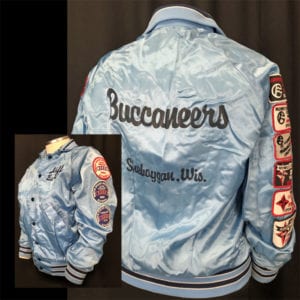
Member Jacket, Buccaneers, 1975-1985
While the modern color guard has roots that can be traced back to military traditions, the organizations also have strong ties to marching bands, both civilian and school. Beginning in the 1950s and 1960s, color guards became one of the fastest growing youth organizations in the country. Barbara Schmidt Wessler was not only founder of the Buccaneers, she remained with the organization throughout their nearly four-decade existence. This coat is one of several she wore as Director of the group.
Founded in 1961 by Barbara Schmidt Wessler and Marcia Joram, the Buccaneers were one of several similar organizations in Sheboygan County. The two worked for nearly a year to recruit participants and formally joined the Midwest Color Guard Circuit in 1962. After performing in association with the Wuerl Band for a number of years, the Buccaneers became independent of the band, added a drum line, and welcomed both boys and girls to their ranks. Over the next thirty-eight years, nearly 15,000 area children participated in the Buccaneers, traveling over 300,000 miles across the United States.
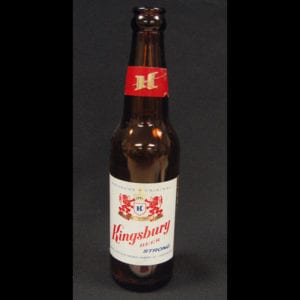
Kingsbury “Strong” Beer Bottle, Kingsbury Brewing Company, 1950 -1963
Both the Kingsbury name and product date back to the Prohibition era, when Sheboygan County’s two fiercest brewery competitors came under one umbrella. In 1926, Gutsch Brewing, and four years later, the brewery division of Schreier folded into the Manitowoc Products Company. The former Gutsch facility in Sheboygan began manufacturing Kingsbury Pale Cereal Beverage following the purchase and the popularity of the product led the company to formally change their name in 1933. Within a decade, Kingsbury beverages became a national staple. By the early 1960s, advertisements for Kingsbury promoted not only the traditional “Aristocrat of Beer,” but also their spring seasonal bock beer and a specialty Christmas brew. Kingsbury’s “Strong” beer was one of several styles the company made in addition to their flagship Kingsbury Pale Ale.
In 1960, G. Heileman Brewing Company of La Crosse purchased a majority share of Kingsbury. Though the firm merged Kingsbury into the LaCrosse operation in 1963, Heilemann continued brewing at the Sheboygan facility for another twelve years. The facility often brewed one of the Kingsbury labels, but also made other Heilemann products including Schmidt, Blatz, and Pfeiffer beers. In February of 1974, Heilemann closed the Sheboygan brewery, ending a nearly 150 year brewing tradition.
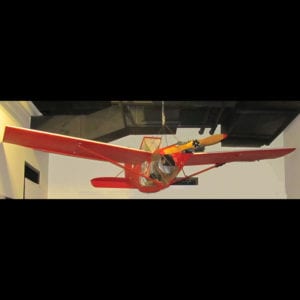
Radio-Controlled Target Airplane, Camp Haven, 1949-1959
Imagine walking the Lake Michigan beach in northern Sheboygan County and coming across a radio-controlled airplane as big as a car. For ten-years, these planes, sleeve kites, and target kites, would land along the shoreline just outside of the community of Haven, as members of the Army, Army Reserve, and National Guard learned anti-aircraft gunnery. In some cases, the target crashed into the waters of the Lake, while others landed on property just outside the boundaries of Camp Haven. This particular R-cat, as they were commonly known, was recovered from the beach area just north of the Camp, having likely landed after all the gas drained from the tank following an artillery hit.
Long before it became Whistling Straits Golf Course, the 160 acres alongside Lake Michigan just outside of Haven was home to Camp Haven. Established in the summer of 1949, the facilities could house up to 700 men, drawing troops from throughout the Midwest. Along with one-thousand feet of firing range, the Camp included artillery storage bunkers, housing tents, an observation tower, mess hall and shower building. For the next decade, the sound of heavy artillery fire might fill the air, as troops practiced shooting 120mm anti-aircraft and .50 caliber machine guns at a variety of targets. As guided missiles became more common, the need to train anti-aircraft gunners waned and Camp Haven ended operations in November 1959.
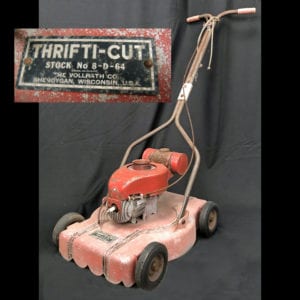
Thrifti-Cut Lawn Mower, The Vollrath Company, 1951-1961
In the years following World War 2, the growth of the American backyard, coupled with increasingly efficient gasoline engines and growing prosperity, brought about a revolution in grass cutting. In 1951, an advertisement touted the ALL NEW Mo-All Jr. Rotary Powered Lawn Mower made by Vollrath. Over the next ten years, the company made the Mo-All in two different sizes, along with adding the Thrifti-Cut Lawn Mower to their product line. All of Vollrath’s mowers boasted economical operation coupled with ease of use, typically for a price between $70 and $100. This particular model, donated to the Museum in 2010, features an engine from Clinton Manufacturing Company.
Established in 1874 as the Sheboygan Cast Steel Company, the Jacob J. Vollrath Company was incorporated in 1884 and featured a line of both cast steel and enameled cast iron implements. By the turn of the century, the company shifted focus entirely to cooking utensils and related kitchenware. By the 1930s, Vollrath began to add stainless steel products to their offerings, along with expanding their product lines beyond food service. Around the same time the lawnmowers were being made, Vollrath also made the Polio-Pak Heater, bringing the company into medical manufacturing, along with introducing aluminum products. Today, Vollrath remains a major manufacturer in Sheboygan.
